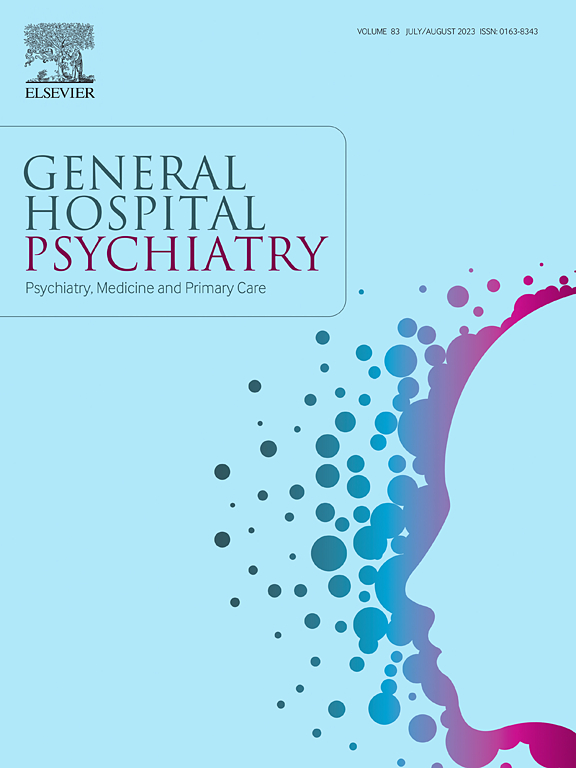神经发散型和典型型儿童紧张症的住院治疗
IF 3.7
2区 医学
Q1 PSYCHIATRY
引用次数: 0
摘要
紧张症是一种神经精神疾病,发生在儿科患者中,伴有一系列相关的医学、精神和神经发育障碍(ndd)。本研究描述了儿童紧张症患者的医院护理,并比较了神经正常患者和ndd患者的治疗方法。方法回顾性队列研究2018年1月1日至2023年6月1日两所学术医疗中心收治的18岁及以下紧张症患者。患者回顾性评估采用临床整体印象改善(CGI-I)由两名独立评论者。结果165例患者因紧张症住院,其中50.3%有NDD。平均年龄为15岁。164名患者接受苯二氮卓类药物治疗,24小时最大中位剂量为6mg劳拉西泮当量,患有和不患有ndd的患者没有差异。14.5%的患者采用电休克治疗(ECT)。神经型患者的住院时间中位数为5天,住院时间长于ndd患者。在有序回归模型中,观察到至少“很大改善”的概率(CGI <;3)为88.3% (95% CI: 82.4%至92.3%),非医学原发性诊断和NDD的患者比非医学原发性诊断无NDD的患者有更低的应答几率。结论患者达到CGI-I评分显示至少“明显改善”的概率为88.3%。所有患者的苯二氮卓类药物剂量和ECT治疗相似,但神经型患者比ndd患者住院时间更长,并且非医学原发诊断的患者有更有利的临床反应的几率更高。需要在受控条件下进行研究,以优化和持久公平的青少年紧张症治疗。本文章由计算机程序翻译,如有差异,请以英文原文为准。
Hospitalizations for pediatric catatonia in neurodivergent and neurotypical patients
Introduction
Catatonia is a neuropsychiatric disorder that occurs in pediatric patients with a range of associated medical, psychiatric, and neurodevelopmental disorders (NDDs). This study describes hospital care of pediatric catatonia patients and compares treatments for neurotypical patients and those with NDDs.
Methods
Retrospective cohort study from 1/1/2018 to 6/1/2023 of two academic medical centers of patients aged 18 and younger with catatonia. Patients were retrospectively assessed using the clinical global impressions-improvement (CGI-I) by two independent reviewers.
Results
One hundred sixty-five patients were hospitalized for catatonia, of whom 50.3 % had an NDD. Median age was 15. One hundred sixty-four patients were treated with a benzodiazepine, with a median maximum 24-hour dose of 6 mg lorazepam-equivalents, which did not differ for patients with and without NDDs. Electroconvulsive therapy (ECT) was utilized in 14.5 % of patients. Median length of medical hospitalization was 5 days and hospitalizations were longer in neurotypical patients than in patients with NDDs. In an ordinal regression model, the probability of observing at least “much improvement” (CGI < 3) was 88.3 % (95 % CI: 82.4 % to 92.3 %), with patients with a non-medical primary diagnosis and an NDD having a lower odds of response than non-medical primary diagnosis without an NDD.
Conclusions
The probability of patients achieving a CGI-I score indicating at least “much improvement” was 88.3 %. Administered benzodiazepine dose and ECT treatment were similar for all patients, but neurotypical patients had longer hospitalizations than those with NDDs and had a higher odds of a more favorable clinical response for patients with non-medical primary diagnoses. Research under controlled conditions is needed to optimize and endure equitable catatonia treatment in youth.
求助全文
通过发布文献求助,成功后即可免费获取论文全文。
去求助
来源期刊

General hospital psychiatry
医学-精神病学
CiteScore
9.60
自引率
2.90%
发文量
125
审稿时长
20 days
期刊介绍:
General Hospital Psychiatry explores the many linkages among psychiatry, medicine, and primary care. In emphasizing a biopsychosocial approach to illness and health, the journal provides a forum for professionals with clinical, academic, and research interests in psychiatry''s role in the mainstream of medicine.
 求助内容:
求助内容: 应助结果提醒方式:
应助结果提醒方式:


